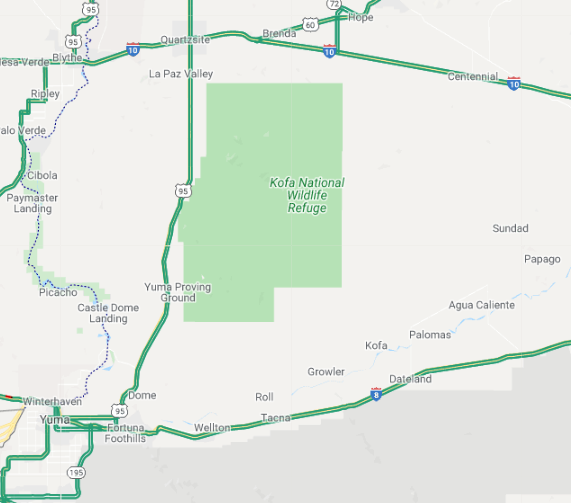Rich history in Arizona wilderness
Rich history in Arizona wilderness

If you look at our AZ511 map as often as we do (and we hope you do!), you’ll notice a huge swath of green-marked land in the southwestern portion of our state. If you zoom in on that area just a little bit, you’ll notice the name: Kofa National Wildlife Refuge.
Running parallel to 43 miles of US Route 95 north of Yuma and 25 miles of Interstate 10 east of Quartzite, the refuge is home to a plethora of flora and fauna. Plants include native palm trees, a rare species of barberry that only grows in the region, and a great many cactus like prickly pear, cholla, pincushion, and some rather imposing saguaros. Animals include familiar desert dwellers like mountain lions, coyotes, foxes, jackrabbits, rattlesnakes, lizards, desert tortoises, Gambel’s quail, cactus wrens and several kinds of bats.
But there is one inhabitant that proved to be the impetus for the refuge’s creation.
Encompassing nearly 1,040 square miles and a more impressive-sounding 665,400 acres, Kofa National Wildlife refuge was established in 1939, originally as a sanctuary for the endangered desert bighorn sheep.
In fact, it was conservationist and British Army major (but born in Minnesota!) Frederick R. Burnham who first recognized the need to save the oversized ovis. He figured what better group to amplify his message than the Boy Scouts of America. Burnham contacted the Boy Scout's Theodore Roosevelt Council, located in Phoenix, and the scouts took the issue head on. In 1936, they embarked on a two year campaign holding radio interviews and school assemblies about the importance of protecting the sheep. They even mounted a “Save the Bighorn” poster contest, and Major Burnham furnished the winners’ prizes.
The scouts succeeded in their mission and The Kofa Bighorn Sheep Range, as it was known at the time, opened on April 2, 1939 as a joint venture of the U.S. Fish and Wildlife Service and the Bureau of Land Management. Fish and Wildlife gained complete control of the land in 1976 and rechristened it Kofa National Wildlife Refuge.
This effort so defined the early days of Arizona's Boy Scouts that the desert bighorn sheep became the group’s official mascot for some time.
The Kofa refuge, and the Kofa Mountain range located within, is named after the long-defunct King of Arizona Mine. The mine was established in the winter of 1896 and officially closed down in the summer of 1910, though ore was mined periodically up until 1937.
Within King of Arizona, miners found plenty of quartz embedded with gold. Estimates at the time claimed that nearly $3.5 million worth of gold was excavated from the mine. Additionally, workers found wulfenite, a striking crystalized mineral with a beautiful orange glow, and two different strains of opal.
Property belonging to the mine was often stamped as “K of A,” thus leading to the portmanteau we use today.
We’ll leave you with one last fun fact: In the early 1940s, General George Patton trained soldiers on the refuge’s rugged terrain. Known as the Laguna Maneuver Area, armored divisions and infantry battalions went through countless exercises and had extensive weapons training using projectiles, mines, and bombs before they were deployed to the deserts of North Africa during World War II. To this day, military munitions can be found throughout the Kofa Wildlife Refuge. Hikers are encouraged to follow the Three Rs: Recognize, Retreat, Report.
You must be at least a little curious by now. So take a day off! Get out of the house and explore over half a million acres of Arizona wilderness, here thanks to due diligence of Arizona's Boy Scouts over 80 years ago. The refuge can be accessed off of Interstate 10 and Vicksburg Road. You can visit az511.gov or download the AZ 511 app for directions.
